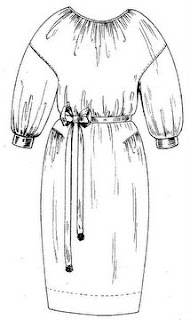 This is how the pattern might look. I suspect the slit would be similar to a dart. The top of the slit is angled upward. I left the bottom of the slit on grain, but it probably should angle down too, making it a true dart, and not a slit.
This is how the pattern might look. I suspect the slit would be similar to a dart. The top of the slit is angled upward. I left the bottom of the slit on grain, but it probably should angle down too, making it a true dart, and not a slit. This is how the sample looks sewn. The yellow arrows indicate the direction of sewing each dart if sewn with a 4/5 spool industrial serger with a shirring arm (my sample is not, so this is an approximation). At the end of each dart is a flat spot because of the physical limitation of the foot and shirring arm getting in the way. Even with my straight stitch machine you can see similar problems. On the left, a pretty little tuck and dimple show up. On the right, the flat spot is more pronounced because the gathers can not start at the end of the dart opening. I also ended up with an open seam where I failed to catch one side. I could easily see these sewing errors occur in an industrial setting.
This is how the sample looks sewn. The yellow arrows indicate the direction of sewing each dart if sewn with a 4/5 spool industrial serger with a shirring arm (my sample is not, so this is an approximation). At the end of each dart is a flat spot because of the physical limitation of the foot and shirring arm getting in the way. Even with my straight stitch machine you can see similar problems. On the left, a pretty little tuck and dimple show up. On the right, the flat spot is more pronounced because the gathers can not start at the end of the dart opening. I also ended up with an open seam where I failed to catch one side. I could easily see these sewing errors occur in an industrial setting.I suspect there may be more to the pattern than I am thinking.


